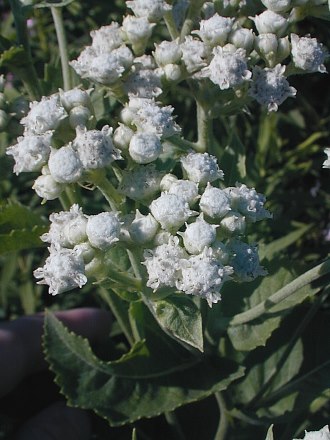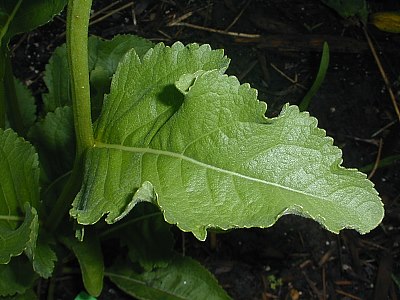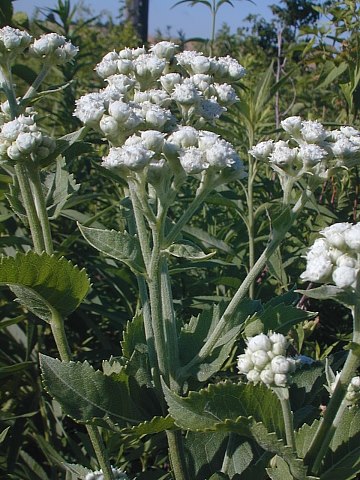Description: This perennial plant is about 2-3' tall while in flower. There is a rosette of basal leaves up to 6" long and 4" wide on long petioles. They are medium green, sandpapery in texture, coarsely serrated along the margins, and broadly lanceolate, ovate, or cordate. From the middle of this rosette, a stout flowering stalk develops, which has smaller alternate leaves on short petioles. Usually there are erect side stems that each develop an inflorescence. An inflorescence consists of flat-headed clusters of small white flowerheads; usually, there are several of them bunched loosely together on the same plant. Each flowerhead is about 1/3" (8 mm.) across, consisting primarily of numerous disk florets, while the few ray florets are greatly reduced in size and barely perceptible. The overall effect is similar to a head of cauliflower. The blooming period occurs from late spring to mid-summer, and lasts about 2 months. There is no noticeable floral scent. Eventually, the flowerheads turn brown, and the achenes develop without tufts of hair. The central taproot is quite thickened and somewhat tuberous in appearance, while rhizomes promote the vegetative spread of this plant.

Cultivation:
The preference is full sun and mesic conditions. However, a small
amount of shade is tolerated, and the soil can vary from moist to
slightly dry. A fertile loamy soil is preferred, although the presence
of some sand or rocky material is tolerated. While established plants
are fairly easy to grow, recent transplants can be temperamental. It is
important to put the transplants into the ground after danger of hard
frost has passed, but before the period of active growth occurs during
the late spring and early summer. Foliar disease isn't a significant
problem. During a drought, some of the lower leaves may turn yellow and
wither away.
Range & Habitat:
The native Wild Quinine occurs occasionally in the majority of counties
in
Illinois, however it is uncommon or absent in many areas of western and
SE Illinois (see Distribution
Map). In high quality habitats, Wild Quinine can be locally
common, while in disturbed areas it is uncommon, possibly because of
the limited dispersion of its seeds. Habitats include mesic black soil
prairies, sand prairies, openings in rocky upland forests, savannas,
scrubby barrens, limestone glades, and thickets.

Faunal
Associations:
The flowers attract Halictine bees, wasps, flies, beetles, and plant
bugs. The beetles usually feed on pollen, while the other insects seek
nectar primarily. The fly visitors include Syrphid flies, Tachinid
flies, Flesh flies, Muscid flies, Anthomyiid flies, and others. Wasp
visitors include Crabronine wasps, Eumenine wasps, Cuckoo wasps,
Braconid wasps, and others. Mammalian herbivores appear to ignore this
plant as a food source because the leaves are sandpapery in texture and
bitter-tasting.
Photographic Location:
The photographs were taken at a remnant prairie along an abandoned
railroad in Champaign County, Illinois, and the webmaster's wildflower
garden in Urbana, Illinois.

Comments: Don't be put off by the lack of conspicuous ray florets on the flowerheads – they are still quite showy, resembling small white pearls from a distance. The leaves are admittedly rather coarse, but they possess characteristics that help this plant to survive in the prairie (as well as one's flower garden). Because of the unique flowerheads, this plant can be confused with no other species in Illinois; there are some close relatives that occur in other states, however. Wild Quinine was used as a substitute for the bark of the Cinchona tree during World War I, when the supply of the latter was disrupted; this was an attempt to maintain the supply of quinine to treat malaria.